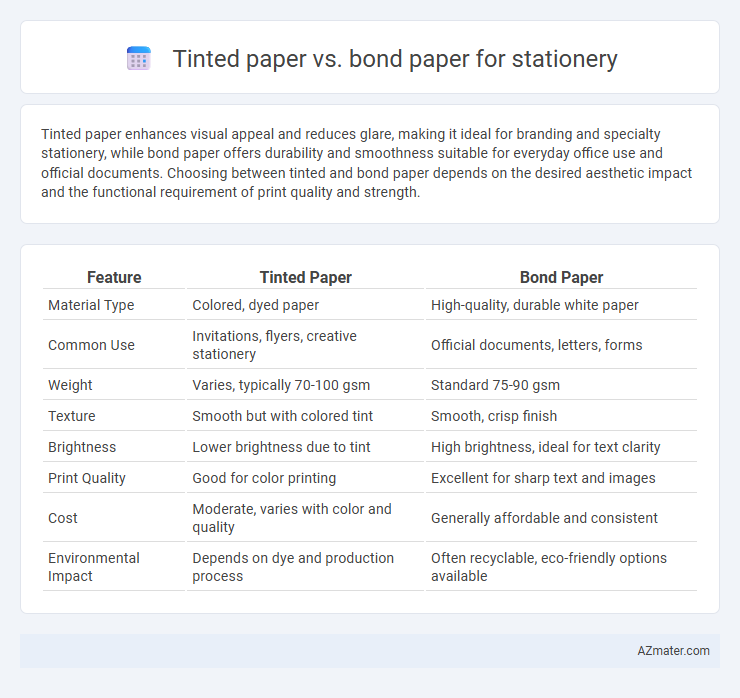Tinted paper enhances visual appeal and reduces glare, making it ideal for branding and specialty stationery, while bond paper offers durability and smoothness suitable for everyday office use and official documents. Choosing between tinted and bond paper depends on the desired aesthetic impact and the functional requirement of print quality and strength.
Table of Comparison
| Feature | Tinted Paper | Bond Paper |
|---|---|---|
| Material Type | Colored, dyed paper | High-quality, durable white paper |
| Common Use | Invitations, flyers, creative stationery | Official documents, letters, forms |
| Weight | Varies, typically 70-100 gsm | Standard 75-90 gsm |
| Texture | Smooth but with colored tint | Smooth, crisp finish |
| Brightness | Lower brightness due to tint | High brightness, ideal for text clarity |
| Print Quality | Good for color printing | Excellent for sharp text and images |
| Cost | Moderate, varies with color and quality | Generally affordable and consistent |
| Environmental Impact | Depends on dye and production process | Often recyclable, eco-friendly options available |
Introduction to Tinted Paper and Bond Paper
Tinted paper, available in various pastel and bold hues, enhances visual appeal and helps organize documents by color-coding in stationery. Bond paper, a durable and high-quality type with a smooth texture, is widely used for official letters, forms, and professional correspondence due to its strength and opacity. Both tinted and bond papers serve specific functional and aesthetic purposes, making them essential choices for diverse stationery needs.
Material Composition and Texture Comparison
Tinted paper is typically made from wood pulp combined with dye or pigment to achieve its colored appearance, offering a slightly rougher texture that enhances grip and writing contrast. Bond paper consists primarily of high-quality cotton or linen fibers, resulting in a smoother, more durable surface ideal for professional documents and stationery. The material composition of bond paper contributes to its superior strength and crisp texture, while tinted paper's textured finish provides visual appeal and distinct tactile feedback.
Color Options and Visual Appeal
Tinted paper offers a variety of color options that enhance visual appeal, making it ideal for creative stationery designs and personalized invitations. Bond paper typically comes in standard white or cream tones, providing a professional and clean look favored for official documents and everyday use. Choosing between tinted and bond paper depends on the desired aesthetic effect, with tinted paper adding vibrancy and bond paper ensuring classic simplicity.
Printing Compatibility and Quality
Tinted paper offers vibrant hues that enhance color contrast, making it suitable for high-quality color printing, whereas bond paper is preferred for sharp, clear text output with inkjet and laser printers due to its smooth surface and brightness. Bond paper's consistent texture ensures fewer ink smudges and better toner adherence, ideal for professional documents and bulk printing tasks. Printing compatibility favors bond paper for laser and inkjet printers, while tinted paper excels in specific creative projects requiring visual impact without sacrificing print clarity.
Writing Experience and Ink Absorption
Tinted paper offers a smooth writing experience with moderate ink absorption, reducing glare and enhancing readability for prolonged use. Bond paper provides excellent ink absorption, allowing for crisp, clear lines without smudging, ideal for detailed writing or printing. Choosing between tinted and bond paper depends on the preference for reduced eye strain versus sharper ink definition in stationery tasks.
Durability and Longevity
Tinted paper offers moderate durability but may fade over time when exposed to sunlight or moisture, making it less ideal for long-term documents. Bond paper is renowned for its high durability and resistance to aging, often preferred for official stationery requiring longevity and archival quality. Selecting bond paper ensures greater preservation of text and color integrity, crucial for important correspondence and legal documents.
Environmental Impact and Sustainability
Tinted paper generally requires additional dyes and chemical treatments compared to bond paper, resulting in a higher environmental footprint due to increased energy and water consumption during production. Bond paper, often made from recycled materials and produced using eco-friendly processes, tends to have a lower carbon footprint and supports sustainability goals more effectively. Choosing bond paper for stationery can reduce waste and promote resource conservation, aligning better with environmentally responsible practices.
Cost Differences and Value for Money
Tinted paper typically costs more than bond paper due to specialized dyes and manufacturing processes, impacting overall stationery expenses. Bond paper offers a more budget-friendly option with consistent quality, making it ideal for everyday printing and professional documents. Evaluating the balance between tint aesthetics and cost-effectiveness helps businesses and individuals maximize value when selecting stationery materials.
Ideal Uses for Tinted Paper in Stationery
Tinted paper is ideal for stationery applications requiring enhanced visual appeal and subtle emphasis, such as personalized invitations, letterheads, and business cards. The colored background reduces glare and highlights printed text, making it perfect for formal correspondence and creative projects. It also helps differentiate documents in multi-page sets or presentations, adding a touch of professionalism and distinctiveness.
Best Applications for Bond Paper in Stationery
Bond paper is highly favored in stationery for its durability and smooth texture, ideal for official documents, letterheads, and resumes that require a professional appearance. Its high-quality cotton or rag content enhances ink absorption and longevity, making it suitable for important correspondence and certificates. Bond paper's crisp white shade and consistent thickness ensure clear printing and a refined finish, perfect for high-volume office use and formal communications.

Infographic: Tinted paper vs Bond paper for Stationery
 azmater.com
azmater.com